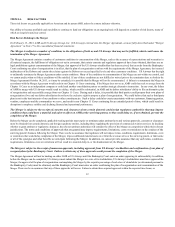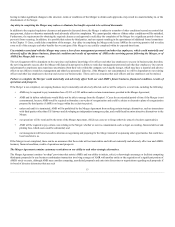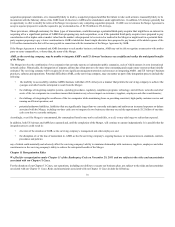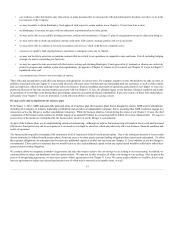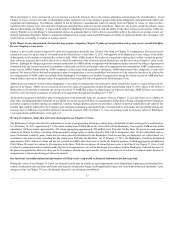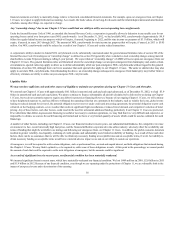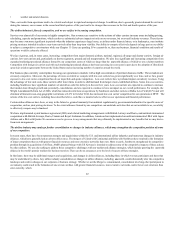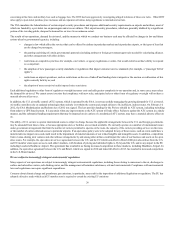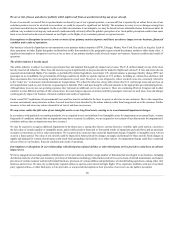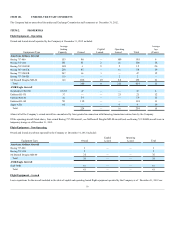American Airlines 2012 Annual Report Download - page 20
Download and view the complete annual report
Please find page 20 of the 2012 American Airlines annual report below. You can navigate through the pages in the report by either clicking on the pages listed below, or by using the keyword search tool below to find specific information within the annual report.
of common stock of AMR (as the surviving company) to our claim holders based on a formula that will take into consideration a number of factors that will
not be determined until the Merger closes.Accordingly, we urge that caution be exercised with respect to existing and future investments in oursecurities or
claims.
Claim holders who recover any portion of their investment by means of a distribution of common stock of AMR (as the surviving company) may
be subject to substantial dilution as a result of future issuances of post-closing AMR common stock.
Whether or not the Merger is consummated, post-emergence AMR will likely issue common stock to satisfy our claim holders. . Any plan of reorganization
will likely include an equity-based incentive compensation plan for officers and employees. In addition, post-emergence AMR could consider issuing
additional common stock in order to raise additional capital or for other reasons. The amount and dilutive effect of any such issuances could be substantial.
Business Risks
We could experience significant operating losses in the future.
For a number of reasons, including those addressed in these risk factors, we might fail to achieve profitability and might experience significant losses. In
particular, the condition of the economy and the high volatility of fuel prices have had, and continue to have, an impact on our business, financial condition
and results of operations, and increase the risk that we will experience losses.
Downturns in economic conditions could adversely affect our revenues, liquidity, business, financial condition and results of operations.
Due to the discretionary nature of business and leisure travel spending, airline industry revenues are heavily influenced by the condition of the U.S. economy
and economies in other regions of the world. Unfavorable conditions in these broader economies have resulted, and may result in the future, in decreased
passenger demand for air travel and changes in booking practices, both of which in turn have had, and may have in the future, a strong negative effect on our
revenues. Stagnant or worsening global economic conditions either in the United States or in other geographic regions and continued volatility in U.S. and
global financial and credit markets may have a material adverse effect on our revenues, liquidity, business, financial condition and results of operations. If
such economic conditions were to disrupt capital markets in the future, we may be unable to obtain financing on acceptable terms (or at all) to satisfy future
capital commitments and otherwise sustain our operations.
We have been adjusting our capacity in response to trends in demand. No assurance can be given that capacity adjustments or other steps we may take in
response to changes in demand will be successful. Capacity reductions or other steps might result in special charges in the future. Further, other carriers may
make capacity adjustments or take other actions which may reduce the expected benefits of any steps we may take to respond to changes in demand. Industry-
wide capacity may increase to the extent the economy continues to recover from the global recession. If industry capacity increases, and if consumer demand
does not continue to keep pace with those increases, we, and the airline industry as a whole, could be negatively impacted.
Our initiatives to generate additional revenues and to reduce our costs may not be adequate or successful.
As we seek to improve our financial condition, we must continue to take steps to generate additional revenues and to achieve a competitive cost structure
during our Chapter 11 Cases. As described above, the AMR business plan contains numerous initiatives to reduce our costs and increase our revenues. The
adequacy and ultimate success of our initiatives to generate additional revenues and/or reduce our costs cannot be assured. Moreover, whether our initiatives
will be adequate or successful depends in large measure on factors beyond our control. For example, any of the following could negatively impact the success
of our initiatives: whether the statutory official committee of unsecured creditors appointed by the U.S. Trustee on December 5, 2011 (Creditors' Committee)
and other creditors will support our plans; whether other parties may raise concerns with or take positions against the business plan; whether we are able to
persuade the Bankruptcy Court to rule in our favor on the numerous matters that will be required to emerge from our Chapter 11 Cases; and, in general, the
overall industry environment, including customer demand, yield and industry capacity growth, actions of our competitors and fuel prices. It could be very
difficult for us to continue to fund our obligations on an ongoing basis, and to be profitable, if the overall industry revenue environment does not continue to
improve or if fuel prices were to increase and persist for an extended period at high levels.
We may be adversely affected by increases in fuel prices, and we would be adversely affected by disruptions in the supply of fuel.
Aircraft fuel has been our largest single operating expense in recent years, and our results are very significantly affected by the cost, price volatility and the
availability of jet fuel, which are in turn affected by a number of factors beyond our control. Although fuel prices have abated from the record high prices of
several years ago, they remain high and extremely volatile. Due to the competitive nature of the airline industry, we have not always been able to pass on
increased fuel prices to customers by increasing fares, and we may not be able to do so in the future.
20




